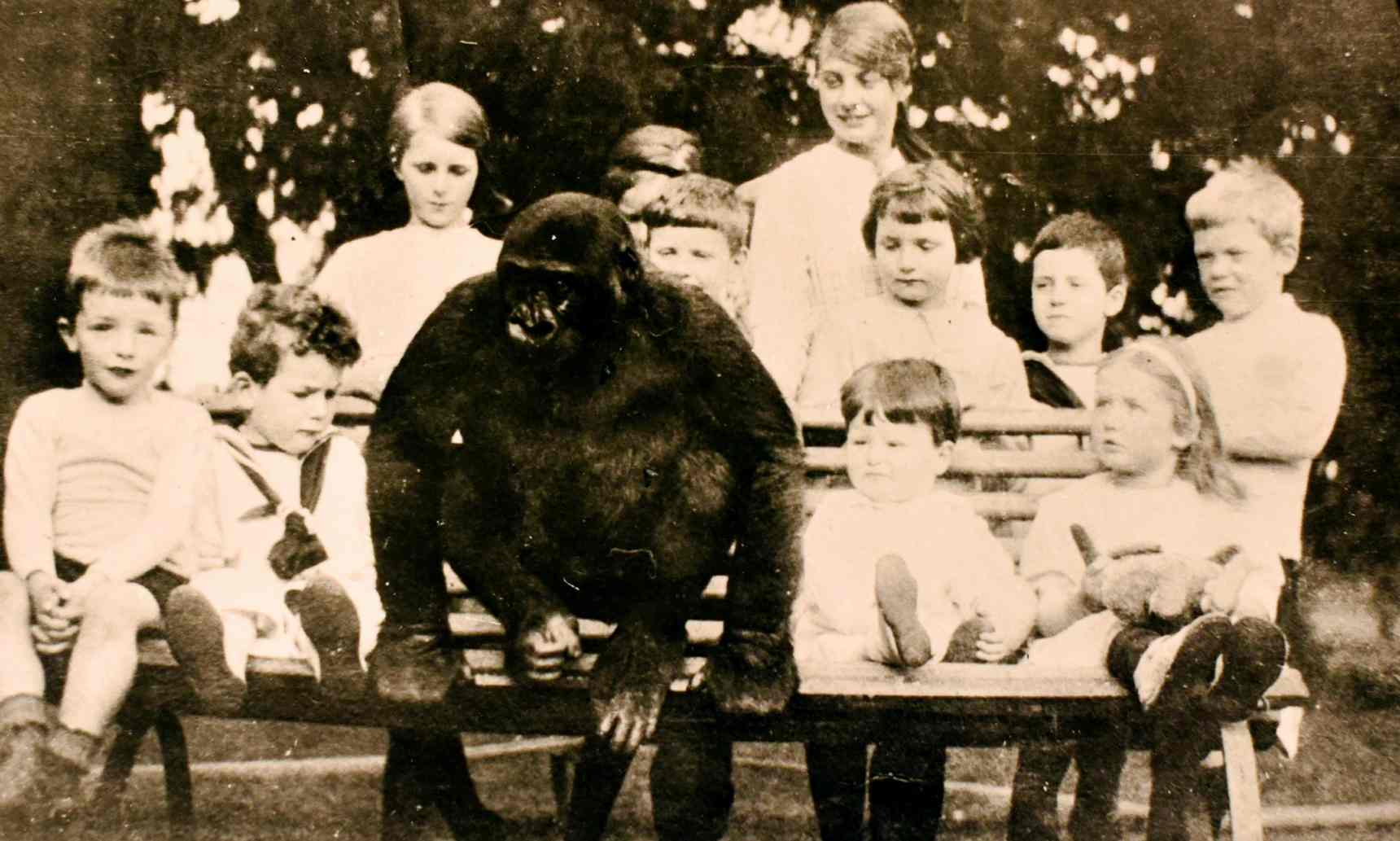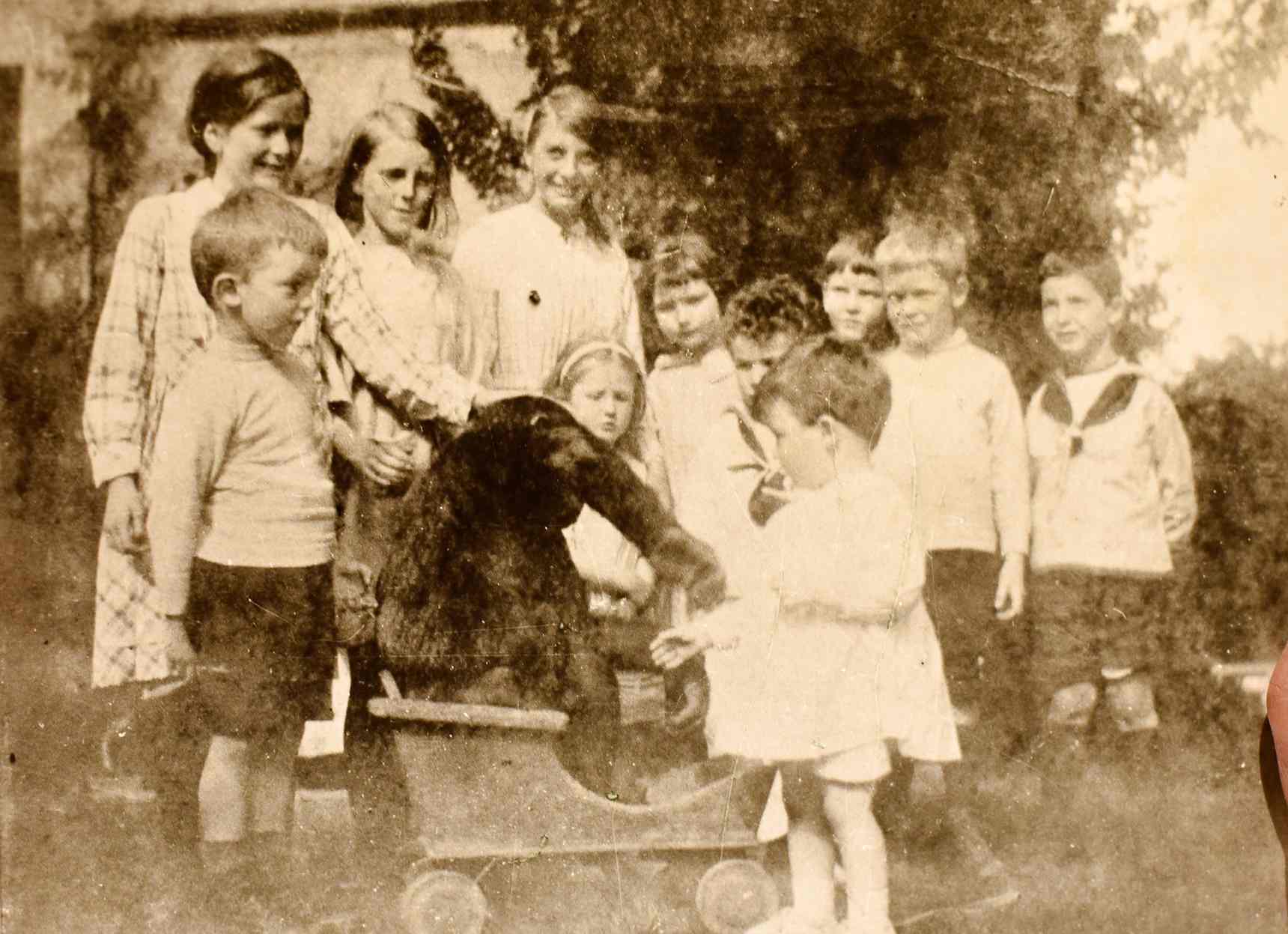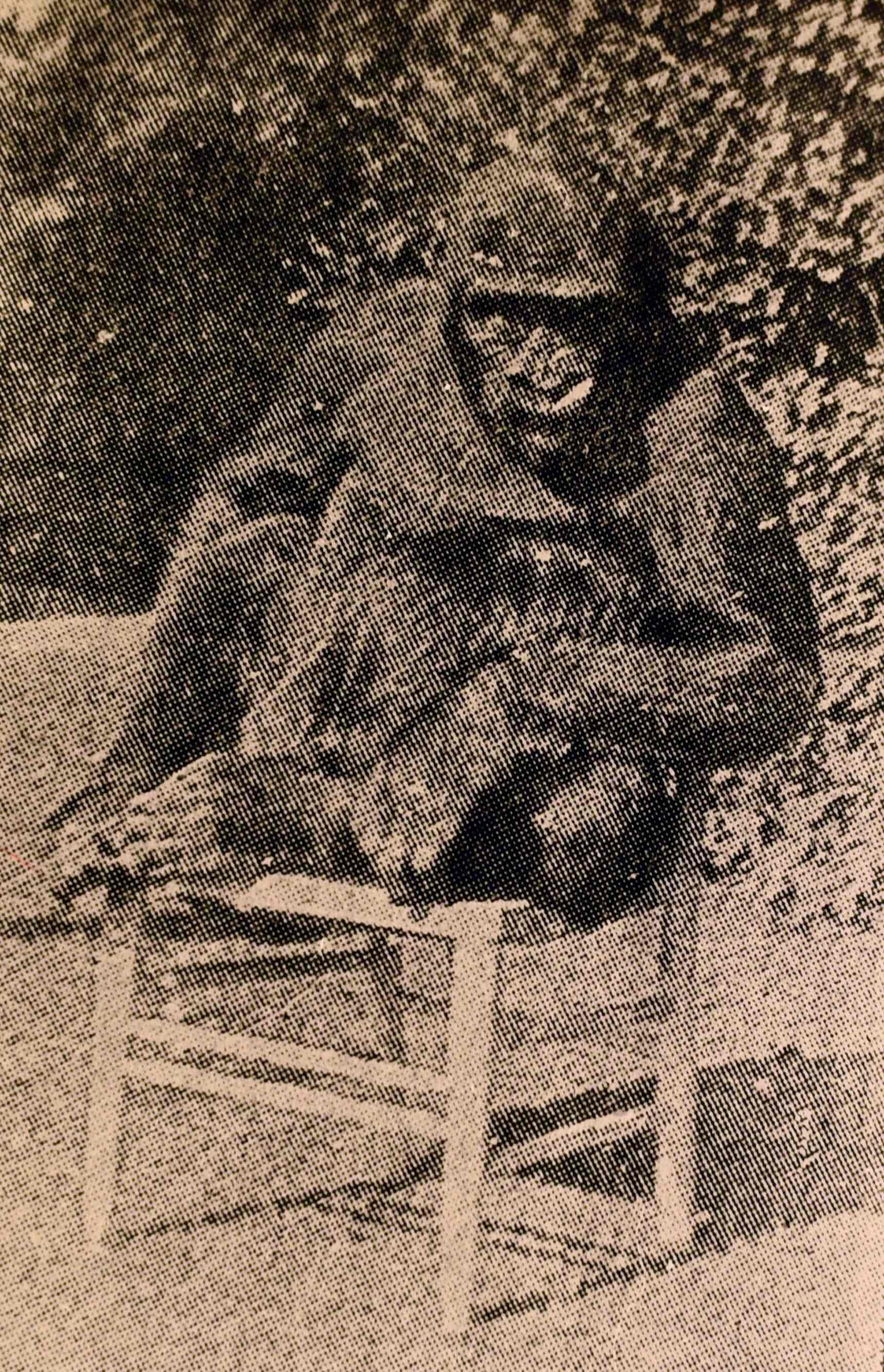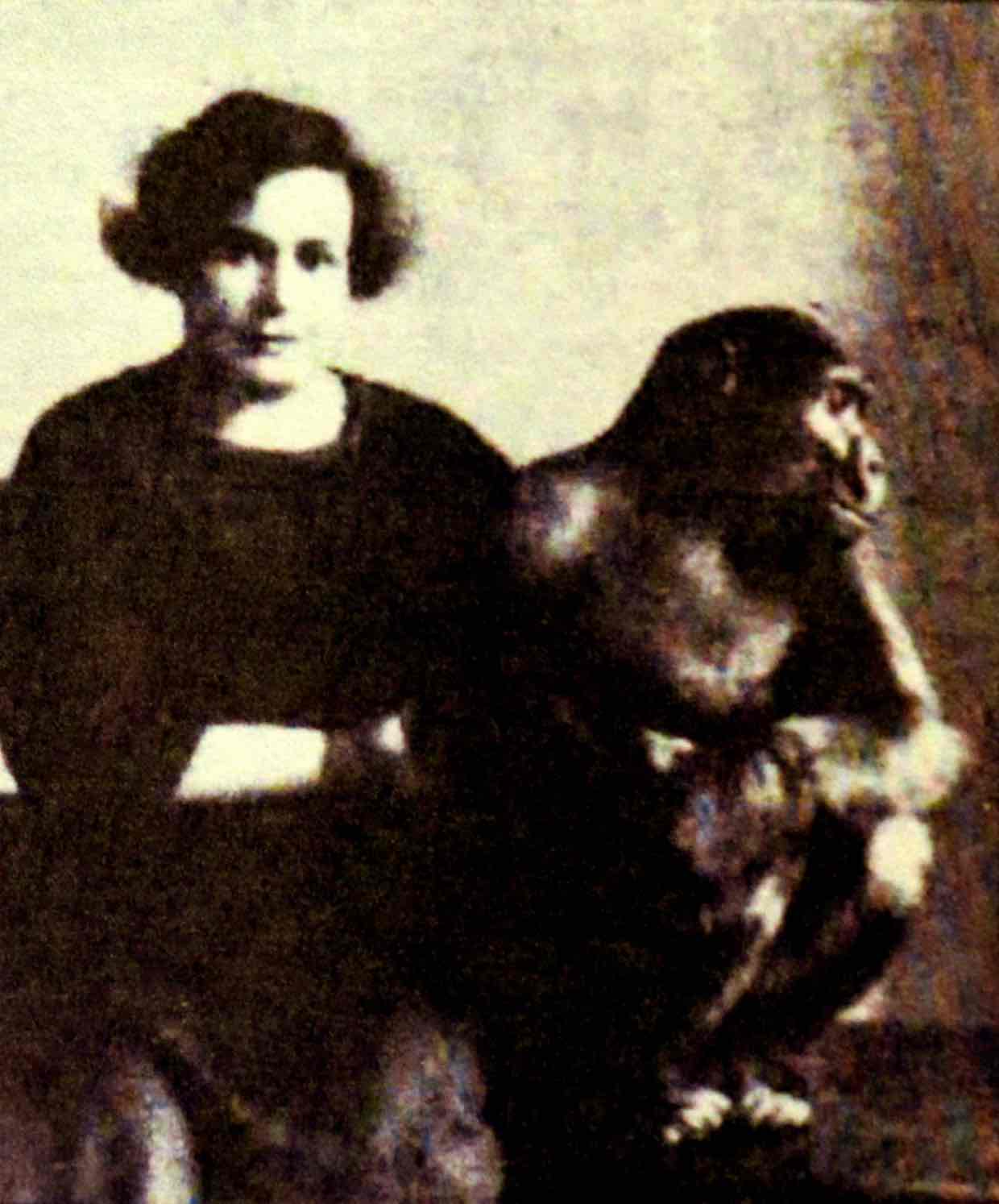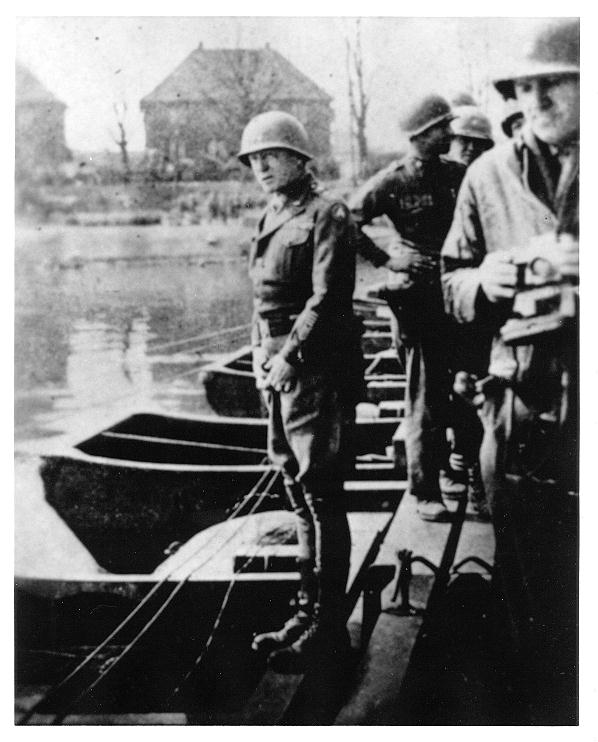
Tag: History
A Gorilla Named John Daniel
The ‘almost human’ gorilla who drank tea and went to school
John Daniel was no ordinary gorilla. For starters, he was called John Daniel. And he had his own bedroom, drank tea and cider, and could purportedly do his own washing up.
The extraordinary tale of the village that adopted its very own gorilla a century ago is told in a new local history book by a Gloucestershire historian.
Margaret Groom, an archivist at the Uley Society, unearthed a collection of photographs of John, which have been published in her book about the village’s history.
The book recounts how villagers in Uley adopted the lowland gorilla after he was captured in Gabon by French soldiers who shot his parents. In 1917, he was spotted for sale in a London department store by Uley resident Maj Rupert Penny, who paid £300 (about £20,000 in today’s money), and named him John Daniel.
Penny’s sister, Alyce Cunningham, raised John as a human boy in the village and used to send John on regular walks with the children of Uley junior school, according to Groom.
Groom told the Gloucestershire Live site: “Until recently, we had people that remembered him walking around the village with the children. He used to go into gardens and eat the roses.
“The children used to push him around in a wheelbarrow. He knew which house was good for cider, and would often go to that house to draw a mug of cider.
“He was also fascinated by the village cobbler, and would watch him repairing shoes. He had his own bedroom, he could use the light switch and toilet, he made his own bed and helped with the washing up.”
Cunningham would also take him to her London home in Sloane Street, where he would attend her dinner parties, drinking cups of tea in the afternoon, Groom said.
But the story of John Daniel has an unhappy ending. “When he grew to full size, Miss Cunningham couldn’t look after him any more,” said Groom. “She sold him to an American for a thousand guineas, believing that he would be sent to a home in Florida.”
Instead, he fell into the hands of Barnum and Bailey circus and was also displayed in the zoo at Madison Square Garden in New York, where his health deteriorated and it was believed he was pining for his former “mother”. Cunningham, alerted by the zoo, set sail immediately, but John Daniel died of pneumonia before she arrived.
His body was given to the American Museum of Natural History for preservation and went on display in the New York museum in 1922, where he remains.
John Daniel is to be the subject of art exhibitions to be held this year at Prema Arts Centre in Uley.
Source…
Amazing Wartime Facts From WWII
- The first German serviceman killed in the war was killed by the Japanese (China, 1937)
- The first American serviceman killed was killed by the Russians (Finland 1940).
- The highest ranking American killed was Lt. Gen. Lesley McNair, killed by the US Army Air Corps.
- The youngest US serviceman was 12 year old Calvin Graham, USN. He was wounded in combat and given a Dishonorable Discharge for lying about his age. (His benefits were later restored by act of Congress).
- At the time of Pearl Harbor, the top US Navy command was called CINCUS (pronounced “sink us”), the shoulder patch of the US Army’s 45th Infantry division was the Swastika, and Hitler’s private train was named “Amerika”. All three were soon changed for PR purposes.
- More US servicemen died in the Air Corps that the Marine Corps. While completing the required 30 missions, your chance of being killed was 71%. Not that bombers were helpless. A B-17 carried 4 tons of bombs and 1.5 tons of machine gun ammo. The US 8th Air Force shot down 6,098 fighter planes, 1 for every 12,700 shots fired.
- Germany’s power grid was much more vulnerable than realized. One estimate is that if just 1% of the bombs dropped on German industry had instead been dropped on power plants, German industry would have collapsed.
- Generally speaking, there was no such thing as an average fighter pilot. You were either an ace or a target. For instance, Japanese ace Hiroyoshi Nishizawa shot down over 80 planes. He died while a passenger on a cargo plane.
- It was a common practice on fighter planes to load every 5th found with a tracer round to aid in aiming. That was a mistake. The tracers had different ballistics so (at long range) if your tracers were hitting the target, 80% of your rounds were missing. Worse yet, the tracers instantly told your enemy he was under fire and from which direction. Worst of all was the practice of loading a string of tracers at the end of the belt to tell you that you were out of ammo. That was definitely not something you wanted to tell the enemy. Units that stopped using tracers saw their success rate nearly double and their loss rate go down.
- When allied armies reached the Rhine, the first thing men did was pee in it. This was pretty universal from the lowest private to Winston Churchill (who made a big show of it) and Gen. Patton (who had himself photographed in the act).
Don’t believe me? Take a look at this: - German Me-264 bombers were capable of bombing New York City but it wasn’t worth the effort.
- A number of air crewmen died of farts. (ascending to 20,000 ft. in an un-pressurized aircraft causes intestinal gas to expand 300%!)
- The Russians destroyed over 500 German aircraft by ramming them in midair (they also sometimes cleared minefields by marching over them). “It takes a brave man not to be a hero in the Red Army”. Joseph Stalin
- The US Army had more ships that the US Navy.
- The German Air Force had 22 infantry divisions, 2 armor divisions, and 11 paratroop divisions. None of them were capable of airborne operations. The German Army had paratroops who WERE capable of airborne operations.
- When the US Army landed in North Africa, among the equipment brought ashore were 3 complete Coca Cola bottling plants.
- Among the first “Germans” captured at Normandy were several Koreans. They had been forced to fight for the Japanese Army until they were captured by the Russians and forced to fight for the Russian Army until they were captured by the Germans and forced to fight for the German Army until they were capture by the US Army.
- The Graf Spee never sank, The scuttling attempt failed and the ship was bought by the British. On board was Germany’s newest radar system.
- One of Japan’s methods of destroying tanks was to bury a very large artillery shell with on ly the nose exposed. When a tank came near the enough a soldier would whack the shell with a hammer. “Lack of weapons is no excuse for defeat.” – Lt. Gen. Mataguchi
- Following a massive naval bombardment, 35,000 US and Canadian troops stormed ashore at Kiska. 21 troops were killed in the fire-fight. It would have been worse if there had been Japanese on the island.
- The MISS ME was an unarmed Piper Cub. While spotting for US artillery her pilot saw a similar German plane doing the same thing. He dove on the German plane and he and his co-pilot fired their pistols damaging the German plane enough that it had to make a forced landing. Whereupon they landed and took the Germans prisoner. It is unknown where they put them since the MISS ME only had two seats.
- Most members of the Waffen SS were not German.
- The only nation that Germany declared was on was the USA.
- During the Japanese attack on Hong Kong, British officers objected to Canadian infantrymen taking up positions in the officer’s mess. No enlisted men allowed!
- Nuclear physicist Niels Bohr was rescued in the nick of time from German occupied Denmark. While Danish resistance fighters provided covering fire he ran out the back door of his home stopping momentarily to grab a beer bottle full of precious “heavy water”. He finally reached England still clutching the bottle, which contained beer. Perhaps some German drank the heavy water…
As printed in, The Victory Division News. No. 4. December, 2000.
The Dumbest Deaths In Recorded History

One of the most notorious villains in history, Attila’s army had conquered all of Asia by 450 AD-from Mongolia to the edge of the Russian Empire-by destroying villages and pillaging the countryside.
How he died: He got a nosebleed on his wedding night.
In 453 AD, Attila married a young girl named Ildico. Despite his reputation for ferocity on the battlefield, he tended to eat and drink lightly during large banquets. On his wedding night, however, he really cut loose, gorging himself on food and drink. Sometime during the night he suffered a nosebleed, but was too drunk to notice. He drowned in his own blood and was found dead the next morning.
Tycho Brahe:
An important Danish astronomer of the 16th century. His ground breaking research allowed Sir Isaac Newton to come up with the theory of gravity.
How he died: Didn’t get to the bathroom in time.
In the 16th century, it was considered an insult to leave a banquet table before the meal was over. Brahe, known to drink excessively, had a bladder condition-but failed to relieve himself before the banquet started. He made matters worse by drinking too much at dinner, and was too polite to ask to be excused. His bladder finally burst, killing him slowly and painfully over the next 11 days.
Horace Wells:
Pioneered the use of anesthesia in the 1840s
How he died: Used anesthetics to commit suicide.
While experimenting with various gases during his anesthesia research, Wells became addicted to chloroform. In 1848 he was arrested for spraying two women with sulfuric acid. In a letter he wrote from jail, he blamed chloroform for his problems, claiming that he’d gotten high before the attack. Four days later he was found dead in his cell. He’d anaesthetized himself with chloroform and slashed open his thigh with a razor.
Francis Bacon:
One of the most influential minds of the late 16th century. A statesman, a philosopher, a writer, and a scientist, he was even rumored to have written some of Shakespeare’s plays.
How he died: Stuffing snow into a chicken
One afternoon in 1625, Bacon was watching a snowstorm and was struck by the wondrous notion that maybe snow could be used to preserve meat in the same way that salt was used. Determined to find out, he purchased a chicken from a nearby village, killed it, and then, standing outside in the snow, attempted to stuff the chicken full of snow to freeze it. The chicken never froze, but Bacon did.
Jerome Irving Rodale:
Founding father of the organic food movement, creator of “Organic Farming and Gardening” magazine, and founder of Rodale Press, a major publishing corporation.
How he died: On the “Dick Cavett Show”, while discussing the benefits of organic foods.
Rodale, who bragged “I’m going to live to be 100 unless I’m run down by a sugar-crazed taxi driver,” was only 72 when he appeared on the “Dick Cavett Show” in January 1971. Part way through the interview, he dropped dead in his chair. Cause of death: heart attack. The show was never aired.
Aeschylus:
A Greek playwright back in 500 BC. Many historians consider him the father of Greek tragedies.
How he died: An eagle dropped a tortoise on his head
According to legend, eagles picked up tortoises and attempt to crack them open by dropping them on rocks. An eagle mistook Aeschylus’ head for a rock (he was bald) and dropped it on him instead.
Jim Fixx:
Author of the best selling “Complete Book of Running,” which started the jogging craze of the 1970s.
How he died: A heart attack….while jogging
Fixx was visiting Greensboro, Vermont when he walked out of his house and began jogging. He’d only gone a short distance when he had a massive coronary. His autopsy revealed that one of his coronary arteries was 99% clogged, another was 80% obstructed, and a third was 70% blocked….and that Fixx had had three other attacks in the weeks prior to his death.
In 1935, Hitler’s Explorers Set Out On A Secret Quest To Begin A Colony On The Amazon River
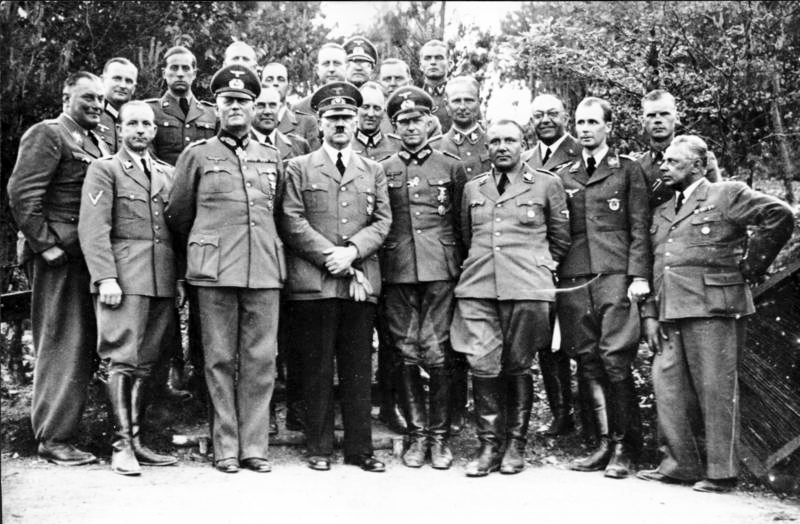
Deep within Brazil’s Amazon rain forest, there’s a Nazi grave flanked by a towering cross with a swastika in a cemetery close to the isolated outpost of Laranjal do Jari. Inscribed on the cross in German is the name of Joseph Greiner who died there of fever on January 2, 1936 ‘in the service of German research.’
So what is it doing there? It’s the sole reminder of a little-known facet of history when Germany sought to found a colony there by bringing a swath of the Amazon River Basin into the Third Reich.
From 1935 to 1937, a team of Nazi explorers were in the region under the leadership of Otto Schulz-Kampfhenkel, a zoologist, documentary filmmaker, and member of Hitler’s SS. They chopped their way through the jungle around Brazil’s border with neighboring French Guiana. They collected indigenous jewelry, animal skulls, and studied topography along the 491-mile-long Jari River, an Amazon tributary.
The exploration began with the customary scientific appearances, explained Jens Glusing, a longtime correspondent for Der Spiegel, the German-language news outlet. He created a book explaining the Guyana Project. When the war began, Schulz-Kampfhenkel seized this opportunity for Nazi colonial enlargement.
He presented his plans to Heinrich Himmler, the head of the SS and the Gestapo, in 1940. The scheme was a way to curb the influence of the United States by taking control of French Guiana and the neighboring British and Dutch colonies. But the dream faded, and it might have been the expedition itself that doomed the venture.
Matters didn’t go well from the start. The expedition had a Heinkel 72 Seekadett seaplane, an example of Nazi industrial prowess – but it capsized after striking driftwood just a few weeks after the expedition started, National Post reported.
From then on they were compelled to rely on native tribes for their survival and finding their way through the jungle. Malaria and other ailments felled them. Schulz-Kampfhenkel, the expedition’s foreman, developed diphtheria and an unknown fever took Grenier’s life.
The mission was abandoned, and today only Grenier’s three-meter-high monument remains as the testament to their failed endeavors.

